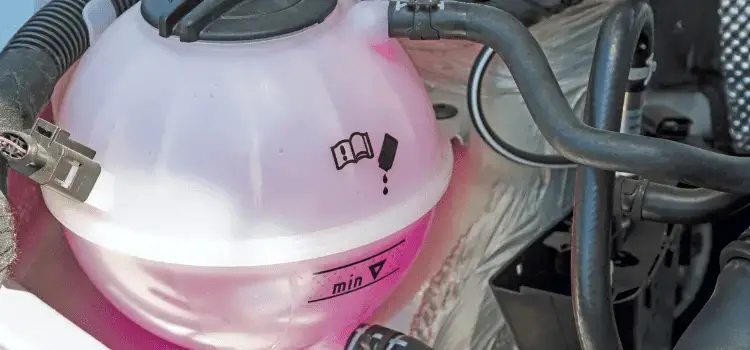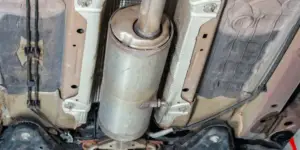You probably didn’t give the heater core a second thought during the spring and summer.
It can start grabbing our attention in the fall and winter if it’s not working properly.
There are six signs the heater core is either broken or not being allowed to do its job by other components failing.
This article will explain in detail all the bad heater core symptoms and what you or your mechanic need to do to get it working properly.
Before we explore all the signs, here are briefly the six main causes.
- A Cold Cabin
- Gurgling Noise
- Low Coolant Reservoir Level
- Overheating Engine
- Wet Front Carpets
- Foggy Car Windows
1. A Cold Cabin
The heater core uses hot coolant from the radiator to heat the cabin. It connects to your vehicle’s cooling system through an inlet and an outlet hose and is a closed circuit. A pump pushes or pulls the coolant through the system,
Hot coolant from the engine enters the heater core through the inlet hose before circulating and coming out from the outlet hose.
A fan behind the heater core blows air through the core to transfer heat from the coolant into the passenger compartment.
When you have a damaged heater core or the hoses are leaking coolant, you will notice a reduction or a complete lack of heat in the cabin.
Solution
You can try using sealant to seal any holes in the heater core. Add the leak sealant to the radiator when your car is cold – the system is pressurized, so wait until you are sure the system is cool before taking off the radiator cap.
Be aware, though; sealant will add non-liquid-based elements to your engine’s cooling system.
It may clog the hole in your heater core but will also circulate through the engine, radiator, and pump.
At best, these sealants should be used as a short-term fix until you can get the heater core replaced.
Always get the system flushed after replacing the heater core if you use sealant to plug it temporarily.
Replacing the heater core can be time-consuming, considering it sits behind the dashboard.
Depending on your car’s make dictates how much dismantling of the dash you’ll have to do before getting to it.
Many visitors also read this article: 4 Easy Ways To Heat Up Your Car Cabin Faster

2. Gurgling Noise
This is quite a common sign but is often overlooked. A gurgling sound indicates that there is air in the coolant circuit. Air pockets in the system prevent the coolant from circulating correctly.
It’s the same principle as your home heating system; when you feel it’s cold, you have to bleed the air out of your radiators. Depending on how much air has found its way into the system – perhaps through a hole in the heater core – and lodged in your heater core dictates whether the heaters core is stone-cold or just not as hot as it was.
Even though it’s a closed system, the air still gets in when coolant leaks out. The worst-case scenario is that the head gasket has blown, allowing gases and air to leak into the coolant system.
This normally happens when the system wasn’t purged of air when the coolant was added during a tune-up—other times when a part was replaced, such as a radiator or a water pump.
Solution
As air rises, it’s a good idea to either jack up the front wheels or park on an incline, forcing the air to move to the highest point in the system.
After turning the heater to max, open up the radiator cap – ensure your car is cold before doing this, as you don’t want to steam hot vapor escaping at speed when you are close by.
As the radiator is now the highest point in the system, the airlock in the heater core should be forced through the system and escape out of the radiator cap.
This detailed video explains the whole procedure step by step.
If your car has a bleeder screw, then open this and let any air out that way
3. Low Coolant Levels
The heater core is part of your car’s cooling system. Therefore, the same coolant that passes through the radiator also goes through it.
Coolant gets lost when you have a leaking heater core every time it circulates through it, constantly lowering in level.
You will find yourself adding coolant every time to avoid overheating, which can get incredibly frustrating.
It would be best if you got this problem fixed immediately because low coolant levels may result in overheating, destruction of the engine block, and other expensive parts to fail.
Solution
Pour a mixture of 50% coolant and 50% water into the radiator/reservoir to keep the car going unless the coolant is pre-mixed.
But if you are in an emergency, plain water instead of coolant will give you enough time to get to the garage.

Often other parts are leaking coolant, the radiator, water pump, and most cheaply of all – the meters of hoses that circulate the coolant could be to blame.
Many visitors read this article next: Low Coolant Symptoms – Full List of 12
4. Overheating Engine
As we’ve alluded to, the heater core and the engine share the same coolant system. If it’s not working correctly for the heater core, it’s not working to cool the engine down either.
When the heater core continuously leaks coolant, the cooling system fails to operate properly, and as a result, the engine overheats and exceeds its normal temperature range of 90.5 to 104.4 C.

Solution
Other signs of an overheating engine include blue smoke leaving the exhaust pipe when you accelerate and a sweet coolant smell under the hood.
If your heater core starts leaking during the summer, try turning the heating or climate control to cold. This will separate the heater core from the cooling system, reducing the loss of coolant on some cars due to them having a bypass valve.
5. Wet Carpets and A Sweet Smell
This is one of the more common signs of a defective heater core. When coolant leaks from the hoses connected to the heater core, it has to end up somewhere, and unfortunately, this might be your carpets.
Since the heater core is positioned behind the dashboard, the coolant seeps into the passenger cabin. Over time it settles on the floor panels or underneath your carpets.
If you regularly clean your car’s interior, you will quickly notice this problem.
Unlike water or snow that may also get your carpets, coolant has a distinct sweet smell and greasy texture and also doesn’t dry off as water would
Solution
Noticing this sign early on may save you a lot of time and money. Once your carpets get saturated with coolant, you have no option but to disassemble the interior parts and remove everything wet.
This boring, time-intensive task involves removing the trimming and even taking out your car seats. You’ll need to scrub the floorboard and the carpet and dry them before you return them to the cabin.

But if you spot these signs on time, you can use a small rag to wipe off the coolant before a mechanic handles the main problem.
6. Fog on the Windshield/Cabin
When your engine gets hot, some coolant begins to evaporate inside the cooling system. This would normally escape through the radiator cap if the pressure got too high.
This vaporized coolant will escape through the leaking heater core and eventually finds its way into the cabin.
You may not notice this fog in the initial stages when you have a small leak. Wiping the windshield using a cloth will smear it and leave stains on the cloth.
But as the leaking worsens, so will the fog, and soon it will be a constant presence in your car whenever you start the engine.
In the worst-case scenario, a vaporized, cloudy coolant mist will suddenly pour into the passenger compartment. It will have a strong smell of coolant that will make driving impossible.
Solution
If you see unusual fog on your windshield, wipe it off with a cloth and smell it. If it has a sweet smell and smears, it is coolant, and it is time to visit your mechanic.
Also, open your windows to avoid breathing in all the coolant vapor.
Cost to Fix
As we’ve seen, often, it’s not the heater core that is faulty but rather other components in the coolant system.
The one really clear sign that points to the heater core are wet carpers on the passenger side of the cabin. – Even here, though, it could be a loose hose instead.
If you have to buy a new heater core, you will pay between $500 to $1000; this includes the part and labor.
The part alone is relatively cheap at around $70 – $220, but the labor costs can be high depending on the location of the core and how easy it is to access it.
In Conclusion
The six signs your heater core is going bad are a cold cabin, gurgling noise, low coolant, an overheating engine, wet front carpets, and fog inside your car. The heater core may be saved if prompt action is taken.













